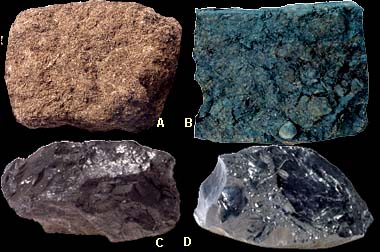Read More About It - A Rock That Burns

Read about them to the left.
Coal is both a rock and a fossil. It burns because it is made of carbon from dead organic matter that has been compressed over time.
In stagnant swamps, where there is little oxygen in the water, material from dead plants doesn't completely decay. It accumulates, forming peat. Over time, peat buried by sediment compresses and heats up. Water and gases are expelled, and carbon is left behind as coal. Ten to twenty meters (about 33–66 ft.) of peat produce 1 meter (about 3.3 ft.) of coal. The greater the compression, the higher the carbon content and the cleaner the coal will burn.
A.
Peat has a carbon content of about 55 percent (to compare, wood is 50 percent).
It represents the first stage of coal development. Peat is found in the
wetlands of northern Illinois.
B.
Lignite is a low-grade coal with a carbon content of about 73 percent.
It burns with a very smoky flame and provides the least heat per pound of
any coal. It is uncommon in Illinois.
C.
Bituminous coal has a carbon content of about 84 percent. It is dark brown
to black, burns with a smoky flame, and is the most abundant of the Pennsylvanian-age
coals. About one quarter of the nation's bituminous coal comes from Illinois.
D.
Anthracite is the highest grade and most compacted coal. It has a carbon
content of over 93 percent. This hard, shiny black coal ignites with difficulty
but burns without smoke. It does not occur in Illinois.